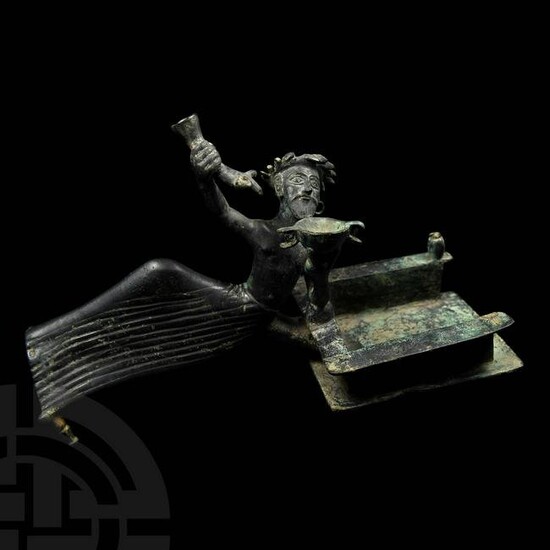Graeco-Parthian Batillum with Banqueteer Holding
3rd-1st century BC. A bronze batillum with a male figure enjoying a symposion or a festive celebration, reclining on a couch with feasting tableware; the figure bearded, sporting massive earrings and a wreath of laurel leaves to the brow, bare-chested and with a pleated mantle covering the legs, one leg raised; right arm elevated and holding a ram's head rhyton, left arm supporting his weight, holding a skyphos beneath the chin on two extended fingers; elbow resting on a ball cushion attached to the rim of an open rectangular scoop with its base supported on stub feet and one baluster remaining to one end. See the Getty Museum, accession number 96.AC.255, for a 3rd century BC batillum decorated with a banqueteer; see also Hanfmann, G.M.A, Detweiler, A.H., ‘Report on the first Campaign on Sardis’ in Türk Arkeoloji Dergisi, Sayi: IX-1, Ankara, 1959, pp.14-19; Garnsey, P., Food and Society in Classical Antiquity, Cambridge, 1999, for discussion on Greek and Roman feasting customs. 1.6 kg, 25cm (10"). Property of a central London gallery; previously with Cahn Auktionen AG, Basle, Switzerland, 13 November 2015, lot 84 (CHF 18,000); acquired on the North American art market 1990s; formerly in a New York private collection formed 1960s; accompanied by an archaeological expertise by Dr. Raffaele D’Amato; and copies of the relevant Cahn Auktionen catalogue pages; this lot has been checked against the Interpol Database of stolen works of art and is accompanied by AIAD certificate number no.10877-180798. The Greek '?????????' 'symposion' was the later part of a formal banquet which took place after the food had been consumed, when the serving of strong drink was accompanied by music, dancing, poetic composition or recital or earnest conversation. The custom has similarities with the Roman convivium and with the customs of many Mediterranean and Western Asiatic people. The Parthian Empire was culturally diverse and included many Hellenic groups; the Arsacid court adopted a range of aspects of contemporary Greek culture, among them Greek military structures and the Greek language as a lingua franca alongside the Parthian (Iranian) language and Aramaic. [A video of this lot is available to view on Timeline Auctions Website]
Condition Report: Fine condition. Rare.
View it on
Estimate
Time, Location
Auction House
3rd-1st century BC. A bronze batillum with a male figure enjoying a symposion or a festive celebration, reclining on a couch with feasting tableware; the figure bearded, sporting massive earrings and a wreath of laurel leaves to the brow, bare-chested and with a pleated mantle covering the legs, one leg raised; right arm elevated and holding a ram's head rhyton, left arm supporting his weight, holding a skyphos beneath the chin on two extended fingers; elbow resting on a ball cushion attached to the rim of an open rectangular scoop with its base supported on stub feet and one baluster remaining to one end. See the Getty Museum, accession number 96.AC.255, for a 3rd century BC batillum decorated with a banqueteer; see also Hanfmann, G.M.A, Detweiler, A.H., ‘Report on the first Campaign on Sardis’ in Türk Arkeoloji Dergisi, Sayi: IX-1, Ankara, 1959, pp.14-19; Garnsey, P., Food and Society in Classical Antiquity, Cambridge, 1999, for discussion on Greek and Roman feasting customs. 1.6 kg, 25cm (10"). Property of a central London gallery; previously with Cahn Auktionen AG, Basle, Switzerland, 13 November 2015, lot 84 (CHF 18,000); acquired on the North American art market 1990s; formerly in a New York private collection formed 1960s; accompanied by an archaeological expertise by Dr. Raffaele D’Amato; and copies of the relevant Cahn Auktionen catalogue pages; this lot has been checked against the Interpol Database of stolen works of art and is accompanied by AIAD certificate number no.10877-180798. The Greek '?????????' 'symposion' was the later part of a formal banquet which took place after the food had been consumed, when the serving of strong drink was accompanied by music, dancing, poetic composition or recital or earnest conversation. The custom has similarities with the Roman convivium and with the customs of many Mediterranean and Western Asiatic people. The Parthian Empire was culturally diverse and included many Hellenic groups; the Arsacid court adopted a range of aspects of contemporary Greek culture, among them Greek military structures and the Greek language as a lingua franca alongside the Parthian (Iranian) language and Aramaic. [A video of this lot is available to view on Timeline Auctions Website]
Condition Report: Fine condition. Rare.



